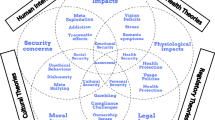Abstract
Users access information services with a variety of devices and with different interaction modes that depend on personal characteristics (including disabilities) and on the context of usage. With the appearance of mobile devices, the industry has focused its efforts on the standardization of device characteristics, thus giving to information providers some content adaptation facilities. However, little attention has been paid to the standardization of user profiles that will allow further customization and adaptation capabilities in mainstream services. This paper will present the authors’ experiences in outlining and implementing user profiles, as well as possible integration paths with device characteristics.


Similar content being viewed by others
Notes
Incorporating Requirements of People with Special Needs or Impairments to Internet-based Systems and Services (IRIS). Partially funded by the Information Society Technologies Programme (European Commission), IST-2000–26211. http://www.iris-design4all.org/
World Wide Web Consortium, http://www.w3.org/.
Wireless Telephony Application Specification, defined also by the Open Mobile Alliance.
ftp://ftp.isi.edu/in-notes/iana/assignments/media-types/
The IPCA (Intelligent Physiological Navigation and Control of Web-based Applications) project (IST-2001–37370). http://www.ipca.info/
References
Architecture of the Universal Remote Console Specification (AIAP-URC) of the Alternate Interface Access Protocol (AIAP) (2002) Draft V2 Working Document, Version 1.4, 11/21/2002. INCITS/V2, Information Technology Access Interfaces Technical Committee of the InterNational Committee for Information Technology Standards
Brown DJ, Lawton J (2001) Design guidelines and issues for Web site production for use by people with a learning disability. Foundation for People with Learning Disabilities. http://www.learningdisabilities.org.uk/html/content/webdesign.pdf?anchor=top and http://www.learningdisabilities.org.uk/html/content/webdesign.cfm. Cited 2001
Finin TW (1989) GUMS: a general user modeling shell. In: Kobsa A, Wahlster W (eds) User models in dialog systems. Springer, Berlin Heidelberg New York, pp 411–430
Gilman AS (1997) Note on CSS/ACSS requirements. http://web.archive.org/web/19991023034216/ and http://www.access.digex.net/~asgilman/web-access/ACSS/status1.html. Cited 1997
Klyne G, Reynolds F, Woodrow C, Ohto H, Butler MH, Tran L (eds) (2003) Composite capability/preference profiles (CC/PP): structure and vocabularies. World Wide Web Consortium. http://www.w3.org/TR/CCPP-struct-vocab/. Cited 25 March 2003
Kobsa A (2001) Generic user modeling systems. User Model User Interact 11:49–63
Koutsabasis P, Darzentas JS, Konstantopoulos M, Spyrou T, Darzentas J (eds) (2001) Specifications for translating user models to communication channels. IRIS Consortium, Deliverable D0301. http://www.iris-design4all.org/IRIS_DOC301/IRIS_D0301.html. Cited 2001
Koutsabasis P, Darzentas JS, Spyrou T, Velasco CA, Mohamad Y, Darzentas J (2001) Towards an environment that supports Internet design for all. In: Avouris N, Fakotakis N (eds) Advances in human-computer interaction, Patras, Greece
Lassila O, Swick RR (eds) (1999) Resource description framework (RDF) model and syntax specification. World Wide Web Consortium. http://www.w3.org/TR/1999/REC-rdf-syntax-19990222/. Cited 22 February 1999
Mohamad Y, Hammer S, Haverkamp F, Noeker M, Tebarth H (2002) First evaluational results in the development of training by animated pedagogical agents (TAPA). In: Proceedings of Mensch und Computer 2002, Teubner, Stuttgart, pp 145–154
Mohamad Y, Velasco CA (2003) A conceptual model to support device-independent and accessible authoring and publishing by a next generation Web publishing framework. In: Proceedings of HCI International 2003, Crete, Greece, 22–27 June 2003
Nevile L (unknown date) Why is accessibility metadata proving difficult? http://dublincore.org/groups/access/poster.html
Picard RW (2000) Toward computers that recognize and respond to user emotion. IBM Sys J 39(3&4):705–719
User Agent Profile Version 1.1. Open Mobile Alliance. http://www.openmobilealliance.org/. Cited 22 October 2002
Velasco CA, Mohamad Y (2002) Web services and user/device profiling for accessible Internet services provision. In: Proceedings of CSUN’s Seventeenth Annual International Conference, Technology and Persons with Disabilities, California State University Press, Northridge, CA
Velleman E (2000) Pre-testing for user profiles to enhance accessibility of digital cartography for the partially sighted. In: Proceedings of CSUN’s Fifteenth Annual International Conference Technology and Persons with Disabilities, California State University Press, Northridge, CA
Zimmermann G, Vanderheiden G, Gilman AS (2002) Universal remote console—prototyping for the alternate interface access standard. In: Carbonell N and Stephanidis C (eds) Universal access: theoretical perspectives, practice and experience. In: Proceedings of the 7th ERCIM UI4ALL Workshop, Paris, France, October 2002
Acknowledgements
Parts of this work have been undertaken in the framework of the project IRIS IST-2000-26211, co-funded by the European Commission. The authors would like to acknowledge the contributions of their colleagues from European Dynamics S.A., University of the Aegean, Fraunhofer-Institut für Angewandte Informationstechnik (FIT), University of the Basque Country and ISdAC (Information Society disAbilities Challenge International Association).
Author information
Authors and Affiliations
Corresponding author
Rights and permissions
About this article
Cite this article
Velasco, C.A., Mohamad, Y., Gilman, A.S. et al. Universal access to information services—the need for user information and its relationship to device profiles. Univ Access Inf Soc 3, 88–95 (2004). https://doi.org/10.1007/s10209-003-0075-5
Published:
Issue Date:
DOI: https://doi.org/10.1007/s10209-003-0075-5




